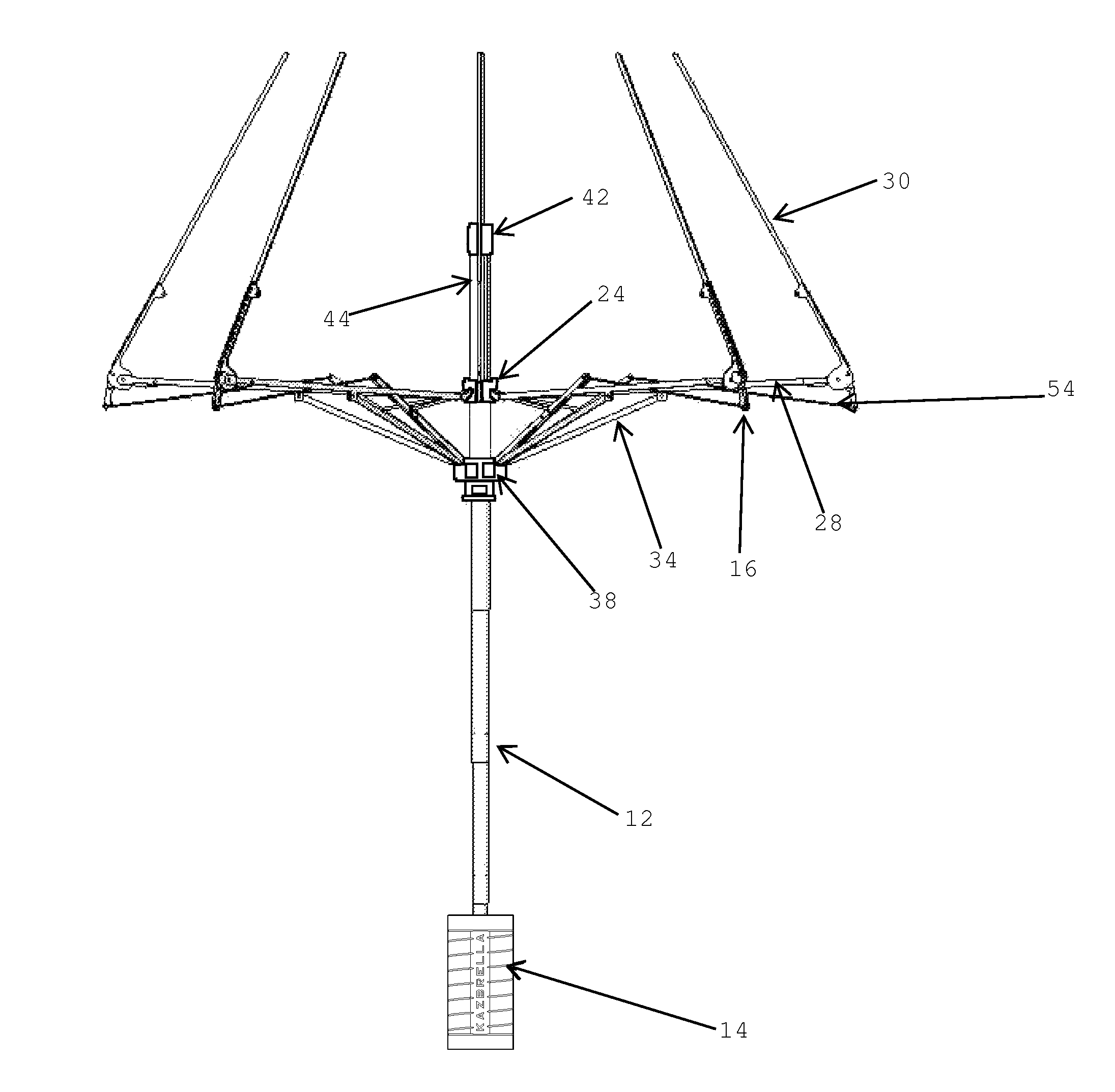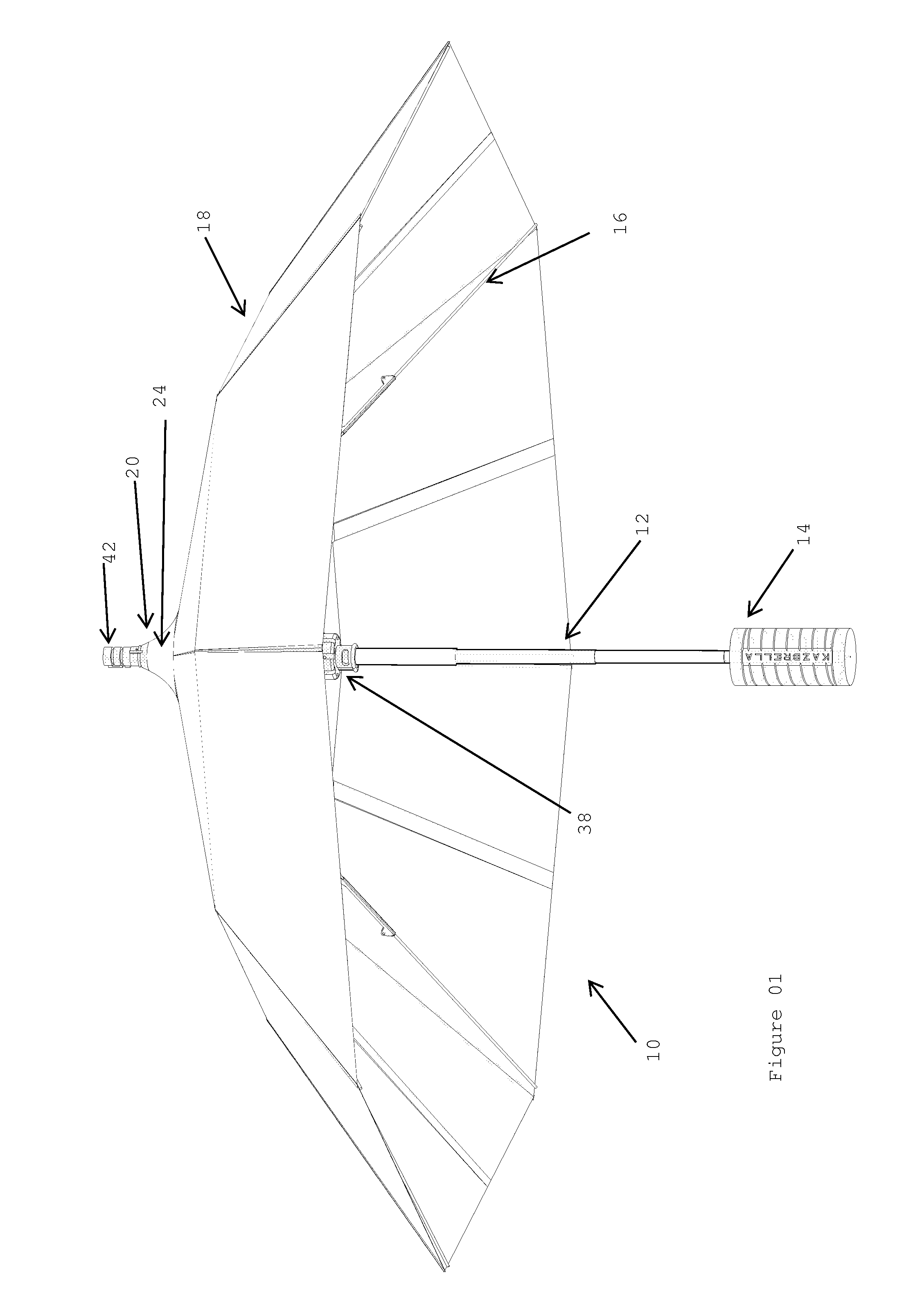Umbrella folding upward and inside out
a folding umbrella and umbrella frame technology, applied in umbrellas, walking sticks, clothing, etc., can solve the problems of limiting the capacity of the umbrella frame, difficult to incorporate the cover and the lid as a single unit, and difficult to store in a cover pouch, so as to reduce the visual impact of the handle, the effect of inherent stiffness
- Summary
- Abstract
- Description
- Claims
- Application Information
AI Technical Summary
Benefits of technology
Problems solved by technology
Method used
Image
Examples
first embodiment
[0072]Referring to FIG. 1 this illustrates an umbrella 10 according to the present invention in its open position. The umbrella 10 has a central spine 12 a handle grip 14, a collapsible canopy framework 16, a main canopy 18 and a mini canopy 20. The main canopy 18 and the mini canopy 20 are both shown as being semi transparent so that the supporting collapsible canopy framework 16 is visible.
[0073]The central spine 12 is telescopic, typically tubular structure that supports the collapsible canopy framework 16 and the main canopy 18. In its lowest section, it supports a handle grip 14. In its uppermost section it supports a pulley system holder which will be described later.
[0074]The handle grip 14 is fixed on to the lowest segment of the central spine 12. This is also usually cylindrical and usually made out of plastic or wood. The optional sleeve cover (not shown) for the umbrella 10 can be fixed onto the handle grip 14.
[0075]The collapsible canopy framework 16 comprises a pluralit...
second embodiment
[0096]FIG. 13 illustrates an umbrella 110 according to the present invention in the open position with the sleeve 182 present and retracted to its open position. The sleeve 182 can be made out of flexible material such as fabric which can roll up or down, or it can be made out of tubing, preferably telescopic with one or more segments and preferably see through to minimise its visual impact. Uniquely, the lid 184 to the sleeve 182 is incorporated onto it. The closing action of the sleeve 182 closes the lid 184 and the opening action of the sleeve 182 opens the lid 184. The advantage of this is that the whole system, including the umbrella 110 and the lid 184 are part of the same unit. Alternatively, the lid 184 of the sleeve 182 can be a separate preferably cylindrical cap to cover the part of the umbrella 110 on the opposite end to the handle 114 or fabric fold and Velcro to fix it. This arrangement has the advantage that the umbrella 110 folds up inside out as well as folding comp...
third embodiment
[0103]Referring to FIG. 19 this illustrates an arm 226 of the collapsible canopy framework 216 of the umbrella 210 according to the present invention. In this case, inner strut 228 is shown on top and the brace 234 at the bottom. The upper crown 224 is shown in two sections, upper section 223 supports the connecting member 256 which connects to the actuation system 256 and the lower section 225 supports the inner strut 228. The brace 234 is supported by the lower crown 238 which also supports the connecting member 256 of the secondary linkage. The connector 277 which connects the two sections 223, 235 of the upper crown 234 allows the upper section 223 to move independently of the lower section 225 up to a certain height and couple them thereafter. On the way down the upper section 223 is free to move until in contact with the lower section 225. In an alternative this can also be achieved using strings or fabric joining the upper section 223 and the lower section 235 of the upper cr...
PUM
 Login to View More
Login to View More Abstract
Description
Claims
Application Information
 Login to View More
Login to View More - R&D
- Intellectual Property
- Life Sciences
- Materials
- Tech Scout
- Unparalleled Data Quality
- Higher Quality Content
- 60% Fewer Hallucinations
Browse by: Latest US Patents, China's latest patents, Technical Efficacy Thesaurus, Application Domain, Technology Topic, Popular Technical Reports.
© 2025 PatSnap. All rights reserved.Legal|Privacy policy|Modern Slavery Act Transparency Statement|Sitemap|About US| Contact US: help@patsnap.com



